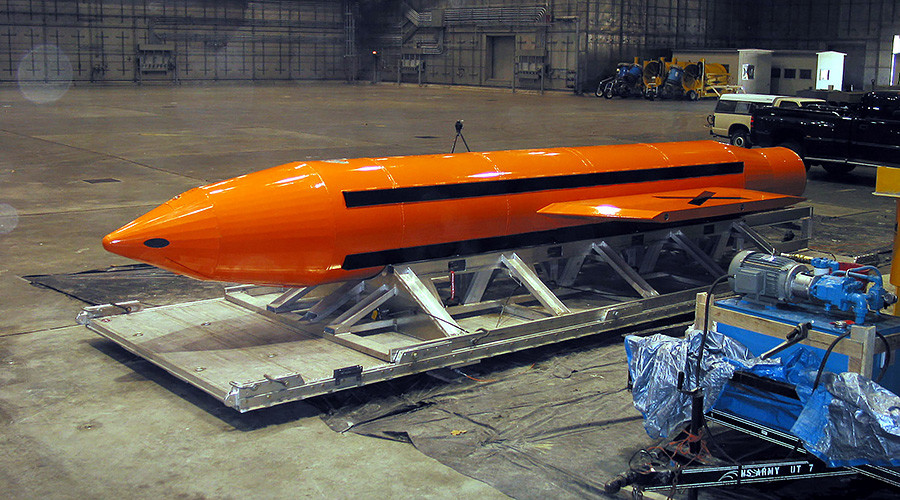KABUL — US forces in Afghanistan have not yet assessed the impact of a massive strike on ISIS militants in the eastern part of the country, a military spokesman said Friday, raising questions about the already controversial decision to deploy a 22,000-pound bomb on the battlefield.
The Afghan Defense Ministry said three dozen fighters were killed in the attack, which used one of the largest non-nuclear bombs in the US arsenal, the GBU-43, against a network of tunnels and bunkers in the east.
A Pentagon spokesman said US forces would not release an official statement on potential damage or casualties caused by the strike, which was carried out in the Achin district of Nangahar province Thursday night.
It was unclear why the Afghan government released casualty figures but US forces did not. For its part, ISIS-linked Amaq News Agency denied that the bombing caused casualties among the militants, according to the SITE Intelligence Group, which monitors online postings from extremist groups and others. ISIS offered no evidence to support its claim.
In Kabul, Navy Capt. Bill Salvin, a spokesman for US forces, said: “We are still conducting our assessment, and at this time have no evidence of civilian casualties as a result of the GBU-43 drop.”
Also Friday, Gen. John W. Nicholson Jr., commander of US forces in Afghanistan, defended the strike as “the right weapon against the right target.” He said it “achieved its intended purpose,” which was to remove the tunnel complex as an obstacle to US and Afghan forces on the battlefield.
US and Afghan troops went on the offensive against the local ISIS branch in March, even as they have continued to battle a Taliban insurgency in the rest of the country. US and Afghan officials have said their goal is to “eliminate” ISIS in Afghanistan this year, but the Trump administration has not said whether it plans to commit more troops to the fight. After nearly 16 years of war, the United States and NATO have struggled with how to wind down the conflict here.
But ISIS affiliate, which is based in Nangahar, emerged relatively recently, surfacing about a year after the parent organization declared a caliphate in Iraq and Syria in 2014. Since then, it has staged deadly attacks on Afghan civilians, particularly in Kabul, but has largely failed to break out of its stronghold in the east. There, the group uses the proximity to Pakistan, which is also plagued by militancy, to build up weapons stockpiles and connect with other extremist militants across the border.
According to Nicholson, the affiliate, known as ISIS in Khorasan Province, is made up mostly of Pakistani and Uzbek militants, along with some Afghan fighters who defected from the Taliban.
In Achin and other nearby districts, the group has terrorized residents, beheading tribal elders, assassinating security officials and closing schools. Even local Taliban commanders have battled the group.
Many of the district’s roughly 100,000 residents have fled, leaving few civilians in the area where the strike took place. No civilians were reported killed, according to US and Afghan officials. Still, some residents and those in neighboring districts described widespread damage and said they heard the blast from miles away.
“It was a powerful bomb. We felt it several kilometers away,” said Khair Mohammad Safi, police chief of the Achin district. Safi, who operates from a neighboring district for security reasons, said he could see flames from the explosion.
“The wave caused by [the blast] was strong. There was a huge fire,” he said. “This was the [ISIS’s] main stronghold. They were annihilated. We needed such a bomb for this place.”
But just this month, US forces announced that they had nearly decimated the group, claiming to have reduced ISIS-controlled territory in Afghanistan by two-thirds. The military also said it had killed about half of the affiliate’s fighters and carried out hundreds of airstrikes on the group’s positions this year alone.
Last week, Army Staff Sgt. Mark R. De Alencar, 37, was killed in Achin by small-arms fire during a combat operation.
“The use of drones turned out to be very effective against ISIS” in Nangahar, said Aryan Youn, a lawmaker from the province, using an Arabic acronym for ISIS. “If that was the case, why did the United States want to use such a sophisticated and powerful bomb?”
Local residents, she said, are worried about the impact of the explosion on their health and farmland. Achin is a heavily agricultural district, where farmers grow wheat, cotton and, intermittently, the poppy crop that is used to make opium.
In a statement Friday, the Taliban also condemned the strike, which it called a “show” by US forces that want to convince the world they are taking a strong stand against ISIS.
The United States had “no justification” for using such a powerful bomb during combat, said the statement.
The Washington Post
